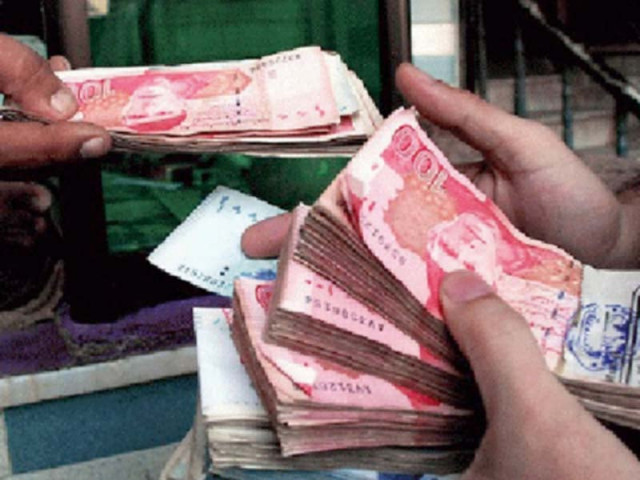Budget deficit surges over 50%
IMF programme becomes root problem, prevents SBP from lowering key rate

The federal government’s budget deficit widened by more than 50%, primarily due to a steep increase in interest payments that reached Rs4.2 trillion during the first half of this fiscal year, casting doubt on the effectiveness of the International Monetary Fund (IMF) programme.
The Rs4.22 trillion interest payments exceeded the net income of the federal government by Rs207 billion during the July-December period of this fiscal year, according to a report released by the Ministry of Finance on Monday.
The fiscal operations report indicates that Pakistan is far from achieving fiscal consolidation despite significantly slowing development expenditures. The root problem of the yawning deficit is now the IMF programme, which also prevents the central bank from lowering interest rates. The high interest rates have failed to curb inflation, remaining in high double digits.

design: mohsin alam
Overall, the federal government has managed to show a primary budget surplus of Rs1.8 trillion, meeting the IMF condition to demonstrate a primary budget surplus of Rs1.42 trillion during the first half. The primary budget surplus is calculated after excluding the cost of interest payments, which now exceed the government’s net income, contributing to a massive debt pile.
The federal budget deficit, including the cost of interest payments, amounted to Rs2.7 trillion or 2.6% of the Gross Domestic Product during the first half of this fiscal year. The deficit was 51% or Rs913 billion higher compared to the same period of the last fiscal year.
Interest payments in the first half increased alarmingly to Rs4.22 trillion, surpassing the federal government’s net income of slightly over Rs4 trillion. The interest cost increased by 64% during the first half compared to the same period of the last fiscal year.
Read Strict measures help meet IMF’s budget deficit target for Q1
In its latest report, the IMF has not accepted Pakistan’s budget allocation cost of Rs7.3 trillion for debt servicing for this fiscal year. Instead, the IMF has shown the debt servicing cost at Rs8.61 trillion, suggesting that the finance ministry understated its debt cost in the budget by Rs1.3 trillion.
Domestic debt servicing amounted to Rs3.7 trillion – higher by Rs1.5 trillion or 64% compared to the last fiscal year. Finance Minister Dr Shamshad Akhtar has already declared that Pakistan’s debt situation is no longer sustainable. The country is now borrowing primarily to meet interest payments, contributing to an elevated debt burden.
The SBP-dominated Monetary Policy Committee on Monday kept the policy rate unchanged for almost two months, which will keep the borrowing cost elevated for the federal government.
The federal government resorted to borrowing for all its activities, including defence expenditures.
In the first half, the federal government’s total expenditures surged by 58% compared to the same period of the previous year. Total expenses amounted to Rs6.7 trillion – higher by Rs2.5 trillion. There was also a 50% increase in current expenditures, amounting to Rs6.6 trillion in six months.
Over a 50% increase in expenses in the first half shows that the Ministry of Finance cannot claim that it has achieved fiscal consolidation.
Compared to Rs196 billion subsidies in the last fiscal year, the government gave Rs375 billion worth in subsidies during the first half, according to the summary. Pensions consumed Rs404 billion in six months, while defence spending stood at Rs757 billion.
Development spending witnessed a cut, slowing down to Rs152 billion – a reduction of Rs9 billion compared to the previous year.
Despite these gloomy figures, the government has managed to show some good performance.
Non-tax revenues witnessed a substantial increase of 116% and increased to Rs1.98 trillion compared to Rs914 billion of the previous year, primarily due to petroleum levy collection and higher profits by the central bank.
The federal government collected Rs473 billion by slapping up to Rs60 per litre levy on petrol and diesel. There was an increase of 165% in petroleum levy collection in just six months compared to a mere Rs178 billion last year.
The SBP gave Rs972 billion in profits – up by 161%. The government has now taken almost 90% of the annual central bank profits in just six months.
The FBR’s tax collection amounted to Rs4.5 trillion in six months – higher by 30% and more than the IMF’s target.
Gross federal revenue receipts amounted to Rs6.5 trillion, an increase of Rs2.1 trillion from the previous year. However, the federal government’s total net income, after transferring provincial shares, stood at Rs4 trillion, not enough to finance interest payments.
The provincial governments have not fiscally behaved during the first half despite there are caretaker governments. Cumulatively they earned Rs3.1 trillion but also spent Rs2.8 trillion, leaving a surplus of Rs289 billion. Out of Rs3.1 trillion, Rs2.5 trillion was given by the centre as their shares in federal taxes.
The provincial governments spent Rs542 billion on development – Rs298 billion or 121% higher than the previous year.
Published in The Express Tribune, January 30th, 2024.
Like Business on Facebook, follow @TribuneBiz on Twitter to stay informed and join in the conversation.


















COMMENTS
Comments are moderated and generally will be posted if they are on-topic and not abusive.
For more information, please see our Comments FAQ